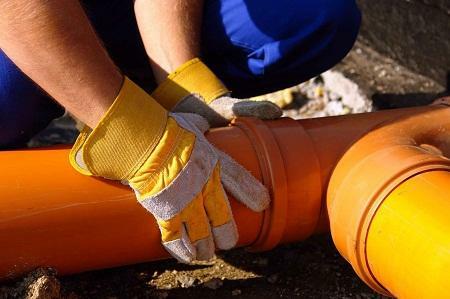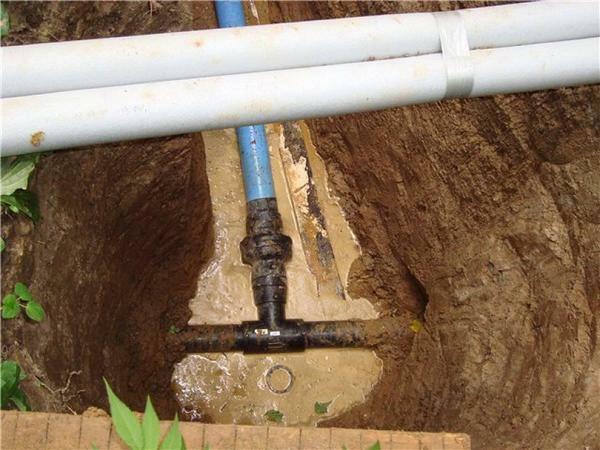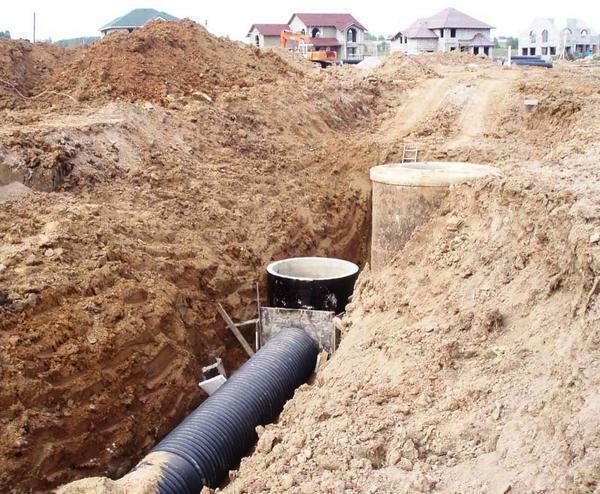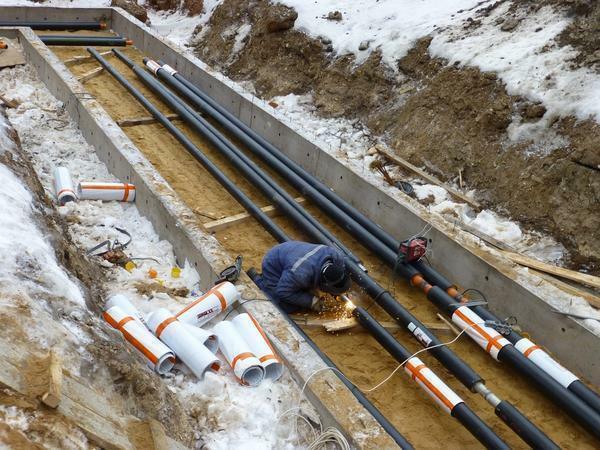Every private house needs sanitation. The technology works is simple, but requires  Before performing sewer lining, it is necessary to get acquainted with the theoretical part of the process camping comply with sanitary regulations. They regulate the layout of pipes.
Before performing sewer lining, it is necessary to get acquainted with the theoretical part of the process camping comply with sanitary regulations. They regulate the layout of pipes.
-
- requirements for water pipes in the ground
- Designing of sewer pipes for outdoor installation
- gasket technology sewage pipes in the ground
- Sanitary requirements for laying sewer pipe in the trench
- Types sewer linings( video)
requirements for water pipes in the ground
drainage pipes stacked simply. The pipes are laid in a dug trench, connected and buried with earth. The location of the pipeline is determined in advance on the completed project. But first you need to determine the material of the pipes. It is also important to take into account the dimensions and diameters of the laying material, the depth of the trench.
 pipes for plumbing, should be placed at a sufficient depth so that they do not freeze in winter
pipes for plumbing, should be placed at a sufficient depth so that they do not freeze in winter
material for sewer pipes:
- Ceramics;
- Concrete;
- Cast iron;
- Polypropylene;
- Asbestos cement;
- Fiberglass.
Cast iron is quite heavy, but inside is not at all smooth. It is not easy to work with such a material, that's why pig iron is rarely chosen. Ceramics are easier to install, but the material is fragile enough, it is easy to damage. Concrete is heavy, so it is practically not used for outdoor sewerage. Asbestos-cement has its advantages, but because of their fragility they are used less and less.
But the best for water supply and sewerage are plastic pipes. They usually have a distinctive orange color. The plastic is light, durable and easy to install.
plastic Advantages:
- ease;
- Strength and strength;
- Chemical resistance;
- Convenient installation;
- Internal smoothness;
- Resistance to low temperatures.
Good option for sewerage - fiberglass. It is also a strong and stable material. But there are significant drawbacks - a lot of weight and high cost.
But different varieties of plastic are resistant to high temperatures. Polyvinyl chloride stands up to 40 degrees, and polypropylene - up to 80 degrees. Polyethylene has average values of heat resistance.
For sewage, round tubes are best suited. The optimal diameter of communications is 110 mm. But with a heavy load on the ground, it is necessary to choose stronger versions with two layers and a corrugated covering.
Design of sewer pipes for outdoor laying
A detailed plan for the placement of pipes in the ground should be made. All calculations should be provided by a specialist. This should be taken care of in advance.
 Sewer pipes of different sizes are sold in any construction shop
Sewer pipes of different sizes are sold in any construction shop
The design takes into account such aspects:
- Possibility of connection to the central sewer;
- Periodicity of the use of pipes;
- Number of inhabitants;
- Sewage flow: to the septic tank, bio-station, accumulator;
- Mounting variant: stand-alone or professional.
The pipe laying is then schematically drawn up. It is best to make a compact plan for placing all communications. In this case, a simple system to increase the efficiency of sewerage.
When building a new house at the same time a scheme is drawn up, how to lay the pipeline.
Pipes should be laid so that all the risers are combined into one. This takes into account the location of all elements of the system. The septic tank is located no closer than 5 m from the house, but it is not recommended to place it too far.
Technology of laying sewer pipes in the ground
Work begins with the design. It is best to provide as much as possible a direct pipeline. At the corners should be mounted inspection wells.
Even for direct sewage, inspection wells are provided. For every 25 m, such an element should be mounted.
The depth of the trench should be properly specified. It is necessary to mount the pipeline below the freezing level of the ground, also take into account the entrance to the septic tank. In this case, it is necessary to provide a slope of the sewage system - 2 cm per meter.
 Trench for sewer pipes is best dig digger
Trench for sewer pipes is best dig digger
It is sometimes difficult to make a deep trench. It is important to ensure thermal insulation so that the drains do not freeze in the winter. The width of the trench should be sufficient for laying pipes and free space of 2 cm on each side. If the pipe diameter exceeds 20 cm, then it will be necessary to increase the free space.
Mounting technique:
- First trench digging;
- At the bottom is 5 cm of sand cushion;
- Then the bottom is well tamped;
- Next, the pipes are laid, they are settled in a trench and connected;
- Then the pipes are connected to the sewer and septic tank;
- The system is then checked for operability and leakproofness;
- The space next to the pipes is required to be covered with sand and compacted;
- The final stage will be filling the pipeline from the top.
The top layer of the soil does not need to be compacted. It is important to take into account a number of professional recommendations. It is necessary to reduce the number of joints, the funnels need to be directed towards the movement of drains, shortening of the socket and faience is prohibited. It is important to make the right bias. If the sewerage is installed in the floor, then the top is poured over with a concrete screed, and for the outside it is enough to fill it with soil, but it is not necessary to compact it.
Sanitary requirements for the laying of sewer pipes in the trench
In order to lay pipes correctly in a private house, all sanitary standards must be observed. There is prescribed the depth of installation of pipes. In addition, important rules of installation are prescribed.
Sanitary standards take into account the installation of manholes, where there are ground changes. And every 25 m with the pipeline in a straight line.
 Before filling the sewer pipes, they must be checked for leaks
Before filling the sewer pipes, they must be checked for leaks
So the depth of the pipeline must be lower by 30 cm of the freezing level of the ground. But with a significant load on the ground, a depth of 9 m is provided. This is optimal on the roads, the roadway.
General sanitary requirements:
- The soil for sewage laying must be compacted. This will strengthen the soil.
- A mandatory slope of the sewage system is envisaged. It is necessary, since there is no pressure in the sewage system. It is required to make a couple of centimeters of slope for each running meter.
- At the corners you need to equip the observation well.
But the design needs better reinforcement and reliability. On the compacted bottom you will need to lay a layer of sand 15 cm thick. The same layer is filled with pipes from above.
Types of sewer gaskets( video)
When sewerage, there are many questions: what pipes to use, the parameters of the trench and the sequence of installation. But all the stages are quite simple and you can do it yourself. To begin with, the trench is dug out according to all the rules, pipes are laid there, they are connected to the communications and the system is filled up. But you can learn and beztransheyny method - a puncture.


